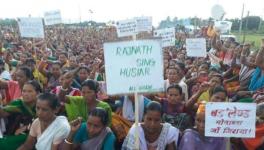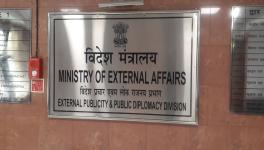Union Budget: No Increase in Allocations for Marginalised Communities Despite Country Lagging Behind in SDGs
The slogan of the Sustainable Development Goals (SDGs), a set of 17 goals adopted by the United Nations which are to be achieved by all the member countries by 2020, is “Leave No One Behind.” It is part of the three guiding principles of the UN’s universal values to achieve the SDGs.
“No One Leaves Behind,” as a transformational value, “represents the unequivocal commitment of all UN Member States to eradicate poverty in all its forms, end discrimination and exclusion, and reduce the inequalities and vulnerabilities that leave people behind and undermine the potential of individuals and humanity as a whole.”
The Indian government has shown its commitment to achieving the SDGs. NITI Aayog developed the country-specific indicators and released an annual report on the achievements of SDGs for each of 17 goals, for all the states. According to the latest NITI Aayog report, the country scored 66 out of 100 on the SDG index. The country scored low on SDG 2 (Zero Hunger), SDG 1 (No Poverty), SDG 5 (Gender Equality), SDG-4 (Quality Education), and SDG 10 (Reduced Inequality).
Achievements of SDGs will depend significantly on the empowerment of the socially marginalised groups like dalits, tribals, denotified and nomadic tribes, religious minorities, people with disability (PWD) and women and girls. There is a need to focus on the empowerment of the people at the margin to “leave no one behind.” This also requires providing budgetary support to the marginalised people.
One way of looking at the budget from the perspective of the marginalised sections is to look at the allocations to the ministries that cater to these sections.
The Union budget provides statements, listing the schemes and programmes across the ministries for the welfare of scheduled castes (SCs) and scheduled tribes (STs). There is also a Gender Budget Statement (statement 13) provided with the budget that shows the amount being spent on women empowerment and women development by various ministries.
ALLOCATIONS TO THE CONCERNED MINISTRIES
Separate ministries cater to the development needs of tribals and minorities. Ministry of Social Justice works to empower dalits, PWD and DNT populations, among others. Women and Child Development Ministry is mandated to empower women.
As shown in the table below, the budget allocations to these ministries are slightly higher than the previous year.
Budget Allocation for Different Ministries of Marginalised (SC, ST, Minority, PWD, Women & Child Development) (Rs in Crore)
Overall, these ministries have received low budget allocations, and there is hardly any substantial increase in the budgets of the MWCD, Ministry of Minority Affairs and the Department of People with Disabilities. There is also a significant reduction in the ministries’ budget in the year 2021-22 from the budget allocations as the revised budgets of all the ministries is lower than the budget estimates for the year 2021-22. The revised budget for 2021-22 has declined by more than Rs 1,000 crore for MTA and MWCD and Rs 500 crore for the Ministry of Tribal Affairs. It means that the programmes of these ministries would have seen a curtailment in the crucial COVID year.
ALLOCATIONS FOR SCs and STs ACROSS THE MINISTRIES
Tribal Sub Plan (TSP) and Scheduled Caste Sub Plan (SCSP) are important strategies for the development of tribals and dalits. As per the 2011 Census, SCs and STs comprise about 16.6% and 8.6%, respectively, in the total population of India. But the allocations under these sub-plans are lower than the population ratio of STs and SCs in the country.
TSP and SCSP 2022-23 (Rs in Crore)
In Union budget 2022-23, the allocation welfare of STs is Rs 89,265 crore (as per statement 10B), which is 5.5% of the total budgetary allocation under Centrally Sponsored Schemes (CSS) and Central Sector Schemes (CS). Similarly, the total allocation for the welfare of SCs is Rs 142,342.36 crore (as per statement 10A), which is 8.8% of the total budgetary allocation under Centrally Sponsored Schemes (CSS) and Central Sector Schemes (CS). The allocations for SCs and STs as a percentage of the total schemes’ budget fall short of their population proportion.
Compared to the previous year, there are only nominal increases of 10 -11% in the total budget for the welfare of SCs and STs in 2022-23.
Gender Responsive Budget?
The government also releases a Gender Budget Statement (GBS) (statement 13) showing the allocations for women and girls across the ministries. The total amount shown under GBS has always been around 5-6% of the total Union budget, and just once crossed 6% since it started in 2005-06. This year again, the total gender budget is pegged to be at 4.33%, which is even lower than the previous year when it was 4.40%.
Gender Budget Statement (Rs in Crore)
Though there is an increase in the size of the gender budget over the previous year, most of the increase is in part B of the gender budget, which lists schemes with 30-99% of women beneficiaries. The increase in part A of the gender budget, which lists the schemes with 100% women beneficiaries, is merely 5% over the previous year.
Of the total budget earmarked under GBS, only 15.7% is allocated under part-A. In comparison, 84.3% of the total gender budget comes from part B of GBS.
SPECIFIC SCHEMES FOR MARGINALISED PEOPLE
If we look at some of the specific schemes important for the empowerment of the marginalised, the umbrella programme for the development of scheduled tribes saw a decline from Rs 4,303 crore to Rs 4,111 crore. The umbrella programme for the development of minorities increased by Rs 300 crore. The budget for Mission Shakti (Mission for protection and empowerment of women) remains stagnated at Rs 3,100 crore. The total for the scholarship for higher education for SCs saw a decline from Rs 450 crore to Rs 364 crore, and the pre-matric scholarships for SCs and others also saw a decline from Rs 725 crore to Rs 500 crore. However, the total umbrella programme for SCs saw a substantial increase of Rs 2,200 crore due to increased allocations in post-matric scholarship for SCs. The rest of the schemes under the umbrella programme either saw stagnated budget or a decline.
Thus, the Union budget 2022-23 has not made any significant allocations for the marginalised communities. The focus on marginalised communities in the budget is necessary from the perspective of social justice and achieving the SDGs for all.
Nesar Ahmad is founder director of Budget Analysis and Research Centre, Jaipur
Get the latest reports & analysis with people's perspective on Protests, movements & deep analytical videos, discussions of the current affairs in your Telegram app. Subscribe to NewsClick's Telegram channel & get Real-Time updates on stories, as they get published on our website.
























